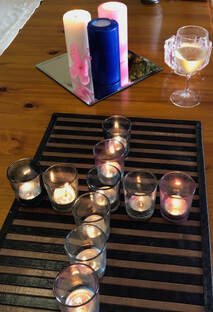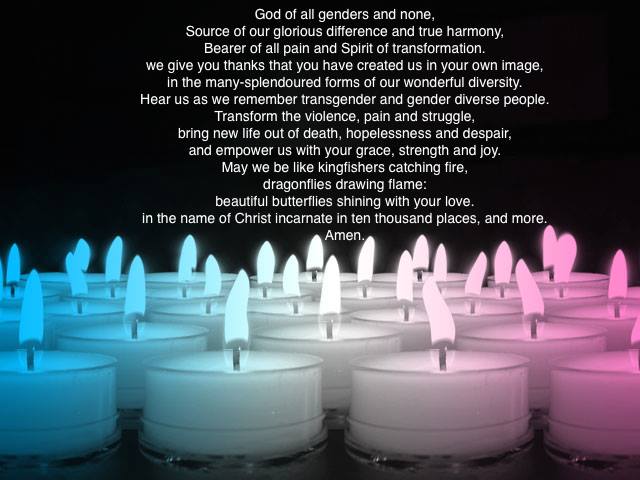|
How do you regard dragonflies? In one of his great poems (As Kingfishers Catch Fire), the poet Gerard Manley Hopkins not only encourages us to be like them, but, in so doing, to be like Christ. Not everyone has always agreed however. In early colonial Australia for example, white fellas tried to kill dragonflies, just as they/we tried to kill so many other life-giving things that they/we did not understand. Those early colonialists saw dragonflies flying around and landing on their valuable horses, and they saw the horses moving and flicking their tails. So they thought the dragonflies were biting and making them crook. The colonialists were making things worse. The dragonflies were actually eating the mosquitoes and the gnats that were troubling the horses. They were life-givers, saviours even, not devils in disguise. In so many positive ways, dragonflies are thus evocative symbols for transgender people today. For, on this Transgender Day of Remembrance, we do well to attend to how bearers of light have been treated as embodiments of darkness. We do well, as our Gospel today (Luke 23.32-43) reminds us, to remember how Jesus was not crucified alone, and how others are also crucified today. And above all, we do well to affirm that it is only in recognising the light, in strange places, that we find salvation and hope for us all…
0 Comments
 Recently I created a 're-membering' blessing ritual for a transgender female who was approaching genital reconstruction surgery. It was custom-made, reflecting aspects of her character and spirituality, not least her commitment to feminist transformation and Celtic spirituality Not all of it may therefore suit others. With her agreement, I offer it however - download a PDF copy here, or see the liturgy below - as a contribution to the development and encouragement of others. I also warmly invite constructive correspondence on this subject. For it is right and proper to mark vital thresholds in our lives as times of spiritual transformation - a point beautifully expressed by John O'Donohue in one quotation used in this liturgy. It is to the great shame of most received institutional spiritual forms that they have been so slow, or actively unwilling, to respond to such needs and joys. Such spiritual intentionality is a gift and invitation to fuller life, both for the person at the centre and for everyone else involved (as our group of friends who were involved in this liturgy experienced) This particular ritual employs Christian themes and language in a contemporary framework, using and adapting other helpful resources. Such readings are examples and may of course be replaced by others more suitable. A key element is re-membering: the re-membering involved in the honouring of time and change (past, present and future), relationships, and the body (personal, communal and ecclesial), As such, as on the particular occasion of its use, an eucharistic celebration is also appropriate. This ritual also owes considerable inspiration to Jewish transgender ritual, particularly in the use of water - for whilst the mikveh, as a feature of significant Jewish transgender reflection, cannot be simply adopted by others, it points us towards depths of mystery and meaning. Other readings, such as those which speak of the transformative powers and thresholds of water within Christian scripture, might also be creatively employed.. A further element to be considered are appropriate colours, fabrics and symbols, including those which reflect the senses, In this case, reflecting Celtic connections, it was helpful to use candle lights and (en)circling. The ritual thus took place with friends gathered in a circle, later around a table for the eucharist, and, for the main part, around a deliberately placed rug. As the photo here shows, this represented a form of mandala, the different layers of a person's past and continuing journey, and ripples or waves of life and love surrounding and enfolding them. At the centre, as a focal point and for the washing, was an 'imperfect' bowl, deliberated shaped as such, representing the nature of creation and the transgender (and every human) life and body. For, like the work of creation, salvation and resurrection as a whole, we are sculptured by grace, which seeks not false ideals of perfection but ever new flourishing through love and healing. With my particular thanks to those who shared in this ceremony and every blessing to others on re-membering pathways. The liturgy follows below (click on Read More below the photo), or is downloadable here...  What does remembering mean for gender diverse people and the body of Christ? I ask that question because, on this All Saints Day, we begin a period of remembrance in both church and world: not least of saints, heroes and role models; of loved ones departed; of the destruction of war; and (in the Transgender Day of Remembrance on 20 November) of transgender and gender diverse people murdered across the globe. My sense is that these things are not unconnected and that they come together because (whatever kind of spirituality we have) all human beings need some dedicated time and space in the cycles of the seasons to engage in what is the 'sacred' task of re-membering. November works, globally, for us all in this: for in the southern hemisphere it marks the drawing to the close of the working year and, in the northern, it marks the coming of the darkness of winter. Not for nothing have human beings also traditionally begun preparing for a mid or end of year festival of light and celebration (known variously but to most today as Christmas). To do that properly however - particularly where death, violence, loss, grief and/or family separation are still real - we need to re-member. So what truths, healing and fresh purpose are we seeking to affirm, and receive, in this, as gender diverse people?... |
AuthorThe Revd Dr Jo Inkpin: Archives
March 2024
Categories
All
|


 RSS Feed
RSS Feed